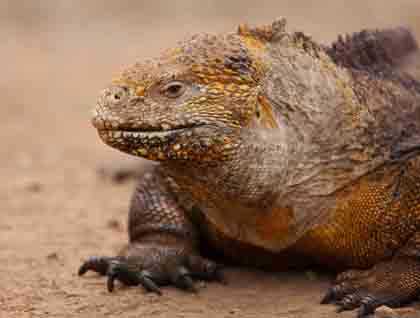Pelicans, terns, land iguanas, and flamingos made this day unforgettable. Today was sunny and warmer that the others. This is because we were visiting the northwestern side of Santa Cruz Island, and here you see a phenomena called rain shadow, where the prevailing winds come from the south. This island has an area of 986 square kilometers (381 sq. mi) and a maximum altitude of 864 meters (2,835 ft.), enough to stop and to keep the cold winds and moisture in the south, not allowing them to pass to the north. Santa Cruz is the second largest island after Isabela and is located in the center of the archipelago. Santa Cruz is a large dormant volcano and it is estimated that the last eruption occurred around a million and a half years ago. Our explorers enjoyed different activities such as hiking, snorkeling and Zodiac rides.
Our first outing took place at Dragon Hill, a place named after the prehistoric creatures (land iguanas) that inhabit this side of the island. As soon as we approached the coastline of Santa Cruz Island, the presence of a magic landscape covered by black lava and white coral sandy beach astonished us. There we were able to see marine iguanas, striated herons and sally lightfoot crabs. The path led us to a small brackish lagoon that was colored by four greater flamingos, white-cheeked ducks and black neck stilts. The giant cactus, unique to this area, made a great place for finding land iguanas foraging.
Later in the morning our nature quest continued in the ocean. Our explorers joined us for snorkeling. Guy Fawkes Islets, which are offshore Santa Cruz, provide a great place for snorkeling. Invertebrates, sea lions and big fish were the attraction in this outing.
Our navigation continued to another place on the coast of Santa Cruz Island known as Eden. A Zodiac ride into a mangrove forest and shallow water captivated our explorers; sea turtles, eagle rays and baby sharks were observed from the Zodiacs. Later the National Geographic Endeavour took us to Daphne Major, a small island north of Santa Cruz and west of Baltra. This inaccessible island is important as the location of multi-decade finch population studies by Peter and Rosemary Grant. In addition, this place is a breeding area for Nazca boobies and frigatebirds. At the end we were very happy having a great time on the bow of our ship, sharing our experiences and our highlights of this magnificent day, in one of the most pristine and exotic places on earth: my home, my Islands.







